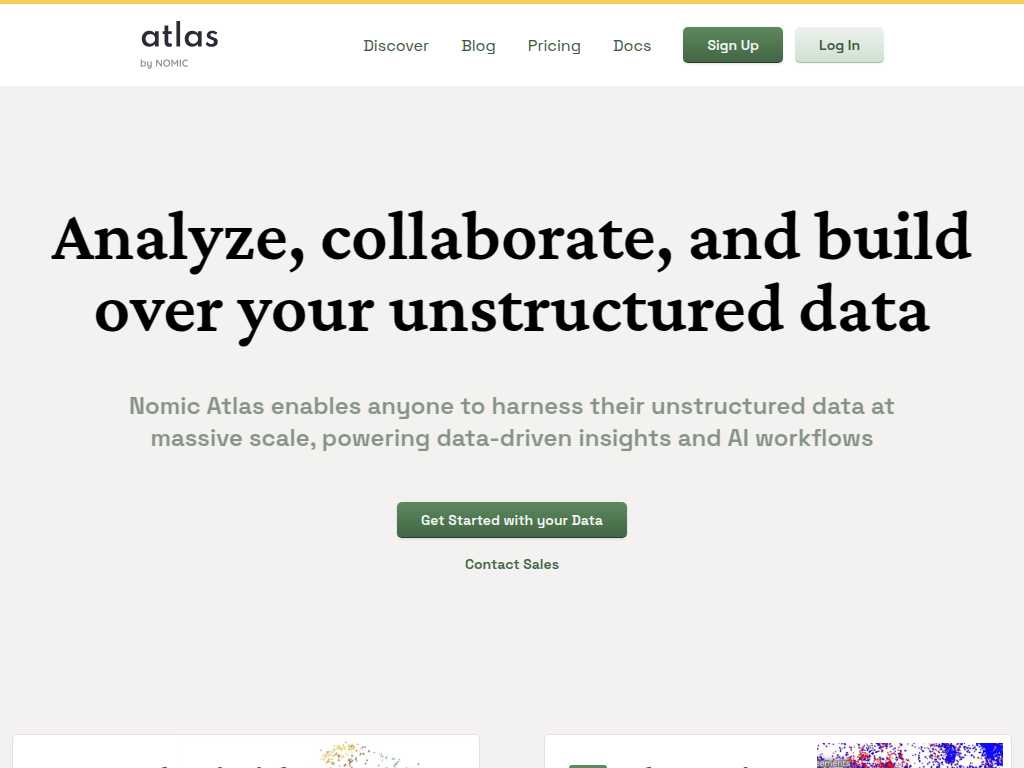Nomic Atlas
Data Analytics

Visualize and Analyze Unstructured Data with Nomic Atlas
Average rated: 0.00/5 with 0 ratings
Favorited 0 times
Rate this tool
About Nomic Atlas
Nomic Atlas is an innovative platform that excels in managing, analyzing, and visualizing unstructured data, including text, images, audio, and video. Its core purpose is to empower organizations and individuals to unlock insights from complex datasets that are otherwise challenging to decipher using conventional data management solutions. This tool is particularly beneficial for data scientists, researchers, and business analysts who deal with large volumes of diverse data types. At the heart of Nomic Atlas is its intuitive Atlas Map Interface, which offers a visual representation of entire datasets on a single screen, organizing similar data points into clusters for easy navigation and understanding. This feature aids users in uncovering patterns and relationships not immediately apparent through traditional methods. Additionally, the platform supports a wide array of data formats, allowing users to upload and manage text documents, images, audio files, and video datasets seamlessly. The built-in vector search capability further enhances the user experience by enabling semantic searches across large datasets via data embeddings. One of Nomic Atlas's standout features is its powerful data cleaning and improvement tools, which permit the removal of undesired data points and help maintain data integrity by detecting and consolidating duplicates. The collaborative data tagging and editing features facilitate teamwork and ensure efficient data management. The platform also offers robust API integration, allowing developers to interact programmatically with the Atlas Map, thus extending its capabilities through integration with existing applications and workflows. Potential applications for Nomic Atlas span several fields, including research and academia, where it allows the visualization of large datasets for scholarly analysis. In business intelligence, organizations use Nomic Atlas to extract actionable insights from unstructured data sets, aiding in strategic decisions. The platform's capabilities also extend to content management, making it an excellent tool for organizing and retrieving multimedia content such as images and videos. In healthcare, Nomic Atlas helps analyze unstructured patient data and clinical trials, aiming to improve medical outcomes. Nomic Atlas distinguishes itself from similar solutions through its user-friendly interface, AI-driven data analysis, scalability to handle large data volumes, and enhanced collaboration features. Although specific technical specifications are limited, users generally require a modern web browser to access this web-based platform. In terms of integration, Nomic Atlas provides API capabilities to facilitate connections with other system environments, ensuring smooth data flow through various organizational processes. While no specific awards have been highlighted, the platform's innovative handling of unstructured data has garnered significant attention in the tech community. Recent developments include the introduction of new embedding models tailored for image datasets, which improve visual data analysis capabilities. Additionally, the ongoing development of a dedicated file store for images simplifies the management of visual datasets, streamlining storage without needing external hosting solutions. Overall, Nomic Atlas presents a versatile and powerful solution for unstructured data management, providing various features and integrations suitable for a wide range of industries and applications.
Key Features
- Interactive data visualization using maps to represent datasets, highlighting clusters and patterns.
- AI-powered embeddings for semantic meaning and relationships, enabling advanced search capabilities.
- Automatic organization into hierarchical topic models for detailed thematic insights.
- Duplicate detection to manage and streamline data efficiently.
- Tools for data labeling, tagging, and collaborative data management.
- Robust API and Python client for programmatic access and integration into workflows.
- Scalability to handle vast datasets, ensuring efficient processing and analysis.
- Support for text, images, audio, and video data types, enhancing versatility.
- Efficient algorithms and architecture for fast data processing and visualization.